To give the interior dynamism, designers often combine different shades and patterns. But if a person does this for the first time and himself, then in such a situation, you must first decide how to glue the combined wallpaper in order to get a single and complete design.
The content of the article:
-
What to look for when choosing a combined wallpaper
- Room dimensions and ceiling height
- Light or dark room
- What invoice
-
Layout options
- Combining wallpaper for zoning
- Vertical combination
- Horizontal combination
- We combine wallpaper with panels
-
How to glue the combined wallpaper
- Single wall design
- monochrome combination
- Complementary combination
- Similar combination
- In the technique of patchwork
- Making transitions
- pattern and pattern
- Niche selection
- Background + pattern
- One drawing in different sizes
- Drawing + geometry
What to look for when choosing a combined wallpaper
Before the room paste wallpaper, making up a combined composition from them, you need to evaluate the size of the room, the height of the ceiling, the degree of illumination.
Room dimensions and ceiling height
When decorating rooms with combined wallpaper, several parameters are taken into account - height, area, shape, illumination and others.
large room
Dark or rich colors work well in a spacious room. It is necessary to maintain a balance so that there is no feeling of tightness.

Organically volumetric patterns fit into a large space. Such wallpapers should be glued on an accent wall, as they will make the atmosphere more comfortable and dynamic.

The bright coloring of hypertrophied images adds coziness. When combined, monochromatic wallpapers of a calm tone are placed next to each other, as they balance the overall composition.

small room
The dark palette is not suitable for small rooms. To visually expand the cramped space, light pastel shades are used. Combined canvases can be plain.

When choosing combined varieties, before gluing wallpaper of two types, they take into account that small unobtrusive patterns fit better into a small volume. They go well with a solid background.

The nearby wallpapers with the same color of the base are well combined. The flower arrangement in this situation does not contrast with the overall color scheme.
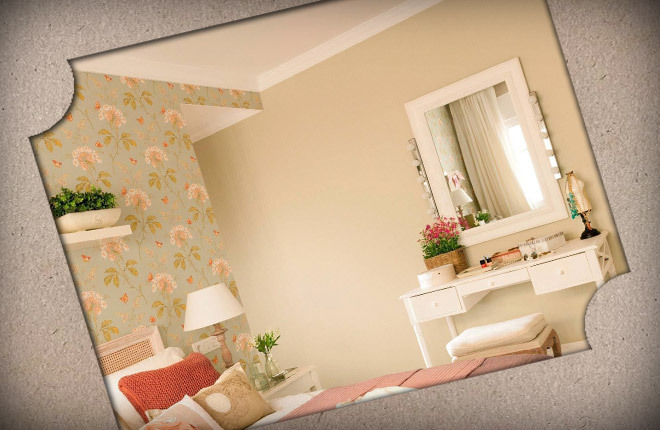
narrow elongated room
Combined different types of wallpapers successfully fit into an elongated narrow room, as they make it square. One common design technique in this situation involves placing light-colored, solid-colored canvases on the end walls with a call to adjacent long surfaces.
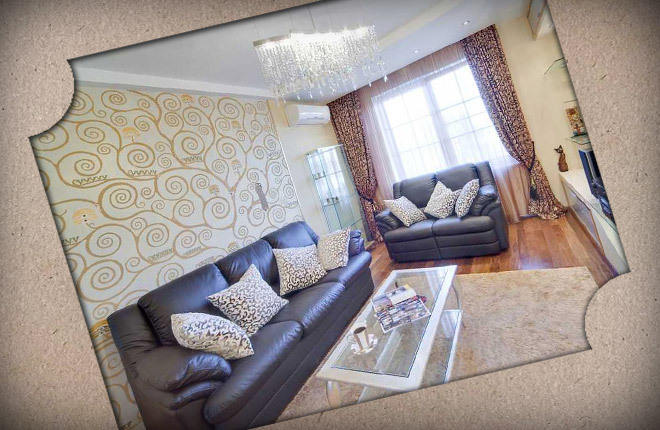
If the entrance to the room is located on the long side, it is recommended to highlight a part of the wall with a juicy pattern or a different tone. On other surfaces, glue wallpaper in a light color scheme. To assess how the perception of the combined volume will change is based on a previously developed scheme.

An unusual design of a narrow room is obtained if two types of wallpaper are beautifully glued, differing in contrasting colors, on opposite long wall surfaces.

Low ceiling
When choosing combined types of wallpaper, be sure to take into account this characteristic. At a height of less than 2.5 m, it is advisable to glue canvases without a rough texture. Preference is given to light pastel or neutral colors.

If there is a drawing, then it should have a small size. Larger compositions are used on one wall as an expressive accent.

Often in a combined interior there are stripes and geometric vertically elongated patterns.

Visually raises the ceiling such a technique as the entry of a strip of wallpaper on the ceiling. You can glue using this technology, for example, the area behind the head of the bed in the bedroom.

High ceiling
If you need to adjust the height of the ceiling plane in the hall more than 3 meters, it is worth gluing wallpaper combined and saturated with color with a large pattern.

The traditional design of the combined elongated space is horizontal stripes alternating in different rhythms.

Light or dark room
Combined wallpapers of different types are used, taking into account the degree of illumination of the space being designed. From this indicator depends on how the patterns and color combinations in the interior will look.
Bright room
With southern orientation of windows, it is not necessary to decorate all the walls with dark wallpaper. An interesting combined result is obtained if the main background is light monochrome. The emphasis is on the wall opposite the window. It can be glued with canvases in a contrasting color scheme.

To give the interior a feeling of freshness, use combined wallpaper in cold colors. You can, for example, glue canvases in a blue tint of varying degrees of saturation.


With north-facing windows, the interior looks dark throughout the day. You can glue very light wallpapers, which decorate only the wall opposite the window frame.

Adds coziness to a dark room with a warm color combination of wallpapers. Brings, for example, a cheerful note of orange color. It goes well with pistachio and white colors.
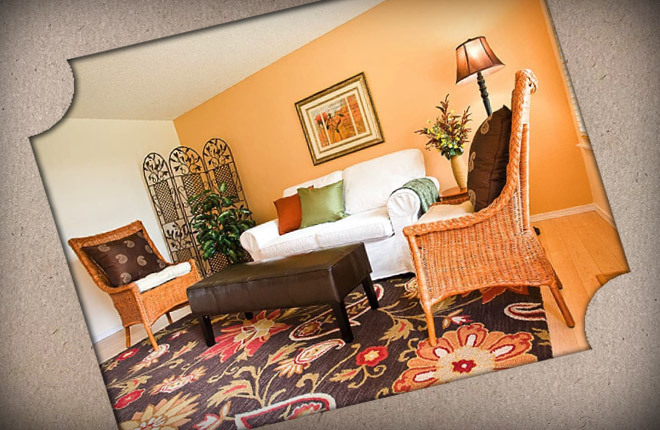
Often, curtains are abandoned to increase illumination. Blinds are a substitute. This allows you to get a feeling of warmth in a dark room with a peach and white combined wall background.

Looks good yellow color on the walls, diluted with white elements. Select combined wallpaper with a different direction of the pattern. If you stick them on opposite walls, the atmosphere becomes more dynamic.
What invoice
Textured wallpapers differ in the presence of embossing on the surface. There are two types of finishing material: for painting and imitating.

For painting - this category includes white canvases with noticeable embossed patterns. They can be geometric, ornate, on a plant theme.

Such material can be painted in the desired shade. Use a convenient roller and quick-drying paint for work.

Imitating - from this group it is easy to choose a finish stylized as wood, brick or masonry.

Textured canvases are often used to highlight a zone in a room that differs in purpose, or to create an original accent.

If embossed and smooth canvases are combined, use a material of the same thickness. This will make the joints less noticeable when gluing.
It is recommended to make the border between different types of combined textured wallpaper in the corners. Here the joints are well hidden.

In a small room, a combined tandem looks good - a combination of glossy and matte wallpapers.

Layout options
There are many ways to connect different finishes in the interior, which makes it easier to choose the right scheme.
Combining wallpaper for zoning
A room of any size looks more comfortable if separate zones are visually demarcated in it. You can solve this problem using wallpapers of different colors or textures:
- The space of the living room-kitchen becomes orderly when color-rich wall decoration is used for the dining room. The relaxation corner attracts with its design with a large floral pattern of a more delicate tone.

- In the children's room, it is worth sticking different wallpapers if you need to allocate a corner for each child. The same combination technique is used when dividing zones (for sleeping, playing, studying).

- Living room zoning can be done without sharp contrast. An interesting result is obtained by applying the technique of combining canvases with a neutral, identical background, but with a different pattern. You can stick them on the combined walls.

- Well visually delimits the space and a more active color scheme, supported by the colors of upholstered furniture.

- An interesting effect occurs if the desired area in the room is highlighted with photo wallpapers suitable for the theme and color. They can be glued near the sofa, decorate a fireplace, dining or TV corner.

Vertical combination
The arrangement of canvases differing in tone, pattern or texture in the vertical direction allows you to visually “raise” the low ceiling. To achieve this result, different methods are used:
- They make the walls plain and light, highlighting one surface on which canvases with a pattern should be glued. It may be contrasting or slightly noticeable.

- To obtain a dynamic combined interior, the distribution of stripes is used, which differ in width and color saturation on several walls.

- Combining 3 types of wallpaper for vertical combination, use canvases of the same thickness. To glue them without eye-catching seams, you need to choose material from the same collection, achieving a textured match.

- An interesting combination of combined canvases can be obtained if the tone of the pattern on one part of the canvases coincides with the shade of plain vertical stripes.

- An amazing combination nuance is obtained by decorating light monochrome walls with richly colored contrasting wallpaper that needs to be cut and pasted in a sinuous strip. The tape of the same shade is continued on the ceiling plane. This technique easily increases the height of the room.
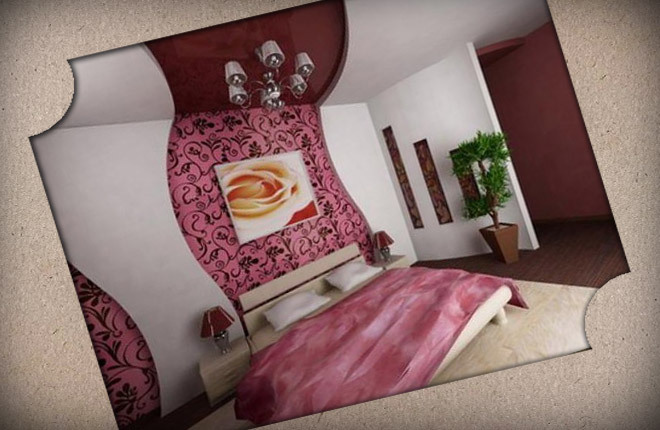
- Use vertically oriented combined wallpaper if you want to mask unsightly wall defects. For example, when diverting attention from irregularities, it is worth sticking a contrasting canvas on the opposite surface.
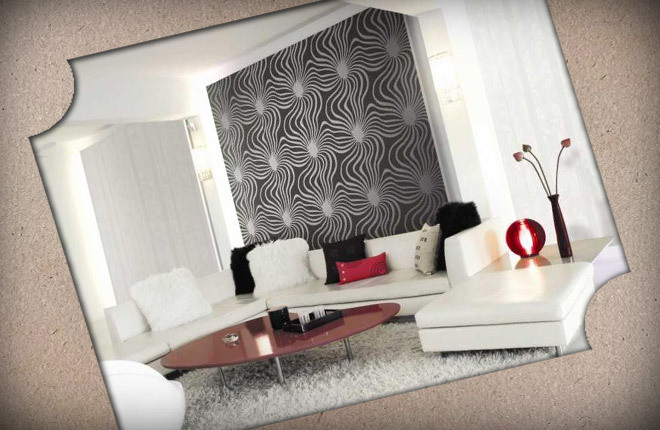
- It also allows a strip of a different color to emphasize an accent piece of a combined interior, such as, for example, a shelf with souvenirs. Well, this technique performs the task of giving diverse functions to even a small space.

- If you stick canvases of a different color on a niche or ledge, you get a more expressive combined sound. In such a corner, a soft sofa is comfortably placed, creating an additional feeling of calm.

Horizontal combination
When arranging the canvases horizontally, it is important to consider how you can combine the finishes to mask noticeable joints. More often, this technique is used if you need to visually level the space of a room with a high ceiling. When configuring, the following options prevail:
- Stripes of combined wallpaper alternate along the entire wall plane. You can glue canvases of both the same and different widths. It is recommended to use no more than 2-3 shades that blend harmoniously with the main background or make up an expressive contrast. Such a hallway testifies to the good artistic taste of the owners.

- There are two types of wallpaper. In the lower part, embossed or striped vinyl wallpapers are often placed. On the rest of the surface it is worth sticking smooth ones (you can take paper ones). The ratio of the combined bands is 1:2. The border is masked with a light narrow molding.

- The use of moldings allows you to create a more complex composition of horizontal combined stripes from wallpaper. They are placed along the entire wall plane, observing the desired sequence in the width of the tapes and the alternation of shades.

- The wall decoration looks interesting with combined canvases of the same width. To balance the lower part is done in a calm neutral tone.

- In a high room, a wide edging of the perimeter of the walls is used for the combined space. They create it from wallpaper, which is distinguished by an original floral ornament, on the border with the ceiling.

- A horizontally oriented patterned narrow strip encircling the monochrome walls approximately at the level of the window sill creates a feeling of a decrease in the overall height.

- If a combined horizontal division of the wall plane into 3 parts is planned, wallpaper of different widths should be glued. The narrow middle strip is made with the most active ornament.

- The horizontal combined design, made up of plain stripes that differ in color and width, goes well with patterned wallpapers. They can be pasted on another wall. In this situation, you need to select repeating shades.

- You can not place horizontal stripes along the entire length of the wall. An unusual combined accent is obtained if a wide light canvas is glued only on that part of the surface of textured “brick-like” wallpaper where the relaxation area is equipped.

We combine wallpaper with panels
The design of rooms using wallpaper acquires a noble touch if some of the paintings are framed with a baguette or moldings, getting a wall panel. There are several ways to create such a decor:
- The golden-burgundy color of the panel fits well into the light monochromatic background of the wall. The frame denoting its borders coincides in color with the main color, which gives the combined interior a noble touch.

- The patterns on the panel can be both bright contrasting and muted, delicate. Such combined compositions are well suited for a child's room.

- The panel, made in bright blue color with a frame of textured white and blue wallpaper, will allow you to highlight the head of the bed. The joints are decorated with a light smooth molding. In combination with a silver quilted bedspread, this combined interior looks fresh and filled with air.
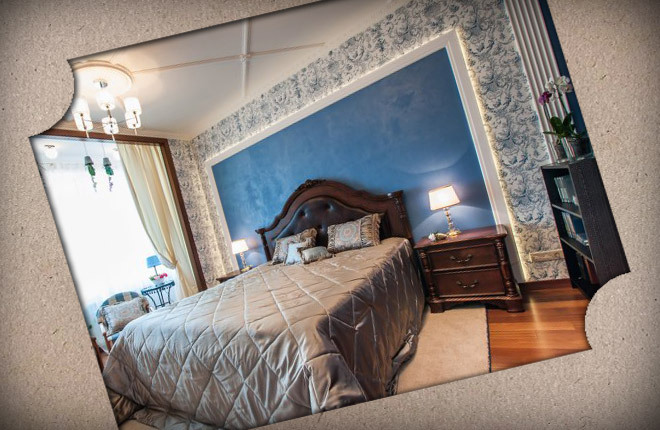
- To get an original panel combined with other types of finishes, you can glue photo wallpapers. They use images on them, for example, with colors that correspond to the overall color sound in the interior.

- It is not difficult to get original types of panels if you first paste wallpaper on the entire wall surface. Then the moldings are attached, framing them with separate sections. The interior takes on a finished look if the background is an elegant neutral coloring of a light pattern.

- If the shade of the background of the wall and the area under the panel selected on it match, the combined interior acquires integrity and naturalness. A fresh nuance is introduced by the white color of the frames and pattern.

- To highlight the panel, different types of framing are used. Such an artistic accessory as a carved gilded wooden frame fits well. The main background of the wall is made neutral monochrome, and glass wall paper with an enlarged floral pattern is used for decoration.
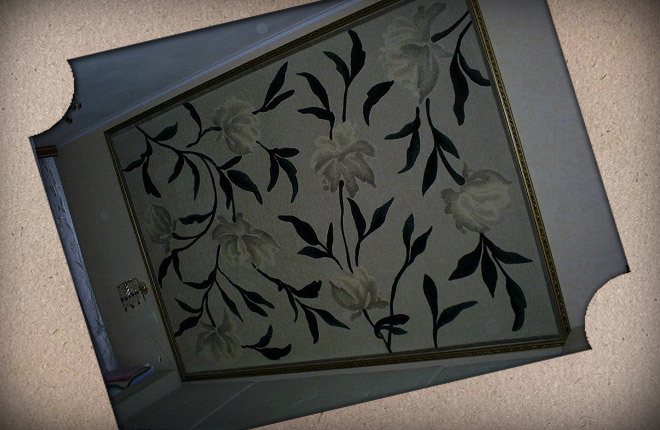
- A panel will acquire an expressive nuance, for which the frame is decorated with an ornament identical to the pattern inside. Supporting the central design created to install the TV, 2 narrow vertically elongated fragments with repeating decor.

- In addition to planar, they use such a type of panel as semi-volumetric compositions. The frame of the desired thickness is sheathed with plywood, and then wallpaper suitable for the pattern can be glued onto it.

- Logically fit into the interior with elements of combined panel decoration, for which they use the same wallpaper with expressive ornament as on the accent wall.

- They create a perspective, expanding the space, murals on a marine theme. You can glue such a panel without additional framing, since the border is clear and even.

How to glue the combined wallpaper
When planning to decorate a room with combination elements, they follow several rules:
- For decoration, choose a wall that attracts attention or requires highlighting, as the basis for a fireplace, dining room, playroom, etc. zones.
- To eliminate inaccuracies, before gluing the combined wallpaper, you need to carry out an accurate markup.
- To keep the seams inconspicuous, connect the individual strips end-to-end.
- When combining vertically, you first need to glue the canvases located from the window.
- If stripes of different colors or textures are placed horizontally, work begins from the top tier.
- When creating a combined in-depth composition, you first need to paste the wallpaper on a niche. Then finish the wall surface.
- To obtain a holistic perception, it is recommended to use material of the same thickness. If possible, buy finishes from one collection.
Single wall design
To obtain a neat combined decor without eye-catching joints, if possible, the wall is completely isolated with wallpaper of the desired decor. In such a situation, you do not have to solve the problem of how to hide the seams.

monochrome combination
The simplest type of layout is to use canvases of the same background. Patterned wallpapers should be glued on the accent wall, and monochromatic varieties are taken for the rest of the planes. This kitchen is very cozy.

The same technique works win-win if the interior design is created with a calm, peaceful atmosphere. The pastel color scheme is well suited for the bedroom.

Complementary combination
Use contrasting shades. They are opposite on the color wheel. For example, blue and orange color or yellow and purple tone. In the interior, such a combined combination often serves as the basis for space zoning.

Similar combination
Use finishes with shades that are adjacent in the color wheel. If they are combined correctly, they get a smooth color flow that does not tire the eyes. More often they choose such an option as a tricolor sound (for example, green, blue, purple). One color will be the base, and the rest will complement.

In the technique of patchwork
Fashionable options include such a combination as the combination of several prints and even textures into a single composition. Make up a patchwork of individual patches, controlling the evenness of the joints. The end result should be a solid composition, combined with adjacent surfaces.

Making transitions
It is not always possible to perform a combined interior in such a way as decorating the entire wall with one type of wallpaper. Often, the docking of the canvases falls on different parts of the surface. To mask the seams, moldings, borders, slats, stucco, baseboards are used.

pattern and pattern
If the proportions are observed, the neighborhood of paintings that differ in ornaments is appropriate. To maintain harmony, it is worth choosing unifying motifs in a combined color scheme. The layout of a large and small pattern is more common.

Niche selection
A non-standard combined design includes the isolation of a niche. To solve it, you need to glue textured, darker than the base background types of wallpaper inside. Lighting enhances the effect.

Background + pattern
The traditional combined interior is predominantly a tandem of plain and patterned canvas. Observe the principle of repeating one of the shades on all surfaces.

One drawing in different sizes
So that a large print does not cause a visual reduction in the volume of the room, it acts as an accent, supporting a smaller dominant pattern.

Drawing + geometry
Balanced with a noble sound, the combination of floral ornament and stripes brings a classic sound to the interior. It is important that the geometric elements are in calm colors that emphasize the main design.

When deciding how to glue combined wallpaper, they first study various design ideas and examples of finished projects. This will allow you to draw up a scheme for combining shades and patterns that will decorate the room.
Have you had successful attempts to use several types of wallpaper? Share your experience in the comments. Bookmark the article so that useful information is always at hand.


